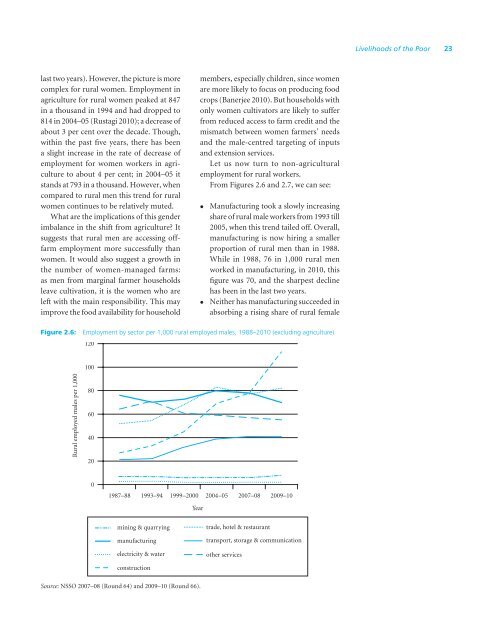SOIL Report 2011 - ACCESS Development Services
SOIL Report 2011 - ACCESS Development Services
SOIL Report 2011 - ACCESS Development Services
- No tags were found...
Create successful ePaper yourself
Turn your PDF publications into a flip-book with our unique Google optimized e-Paper software.
Livelihoods of the Poor 23last two years). However, the picture is morecomplex for rural women. Employment inagriculture for rural women peaked at 847in a thousand in 1994 and had dropped to814 in 2004–05 (Rustagi 2010); a decrease ofabout 3 per cent over the decade. Though,within the past five years, there has beena slight increase in the rate of decrease ofemployment for women workers in agricultureto about 4 per cent; in 2004–05 itstands at 793 in a thousand. However, whencompared to rural men this trend for ruralwomen continues to be relatively muted.What are the implications of this genderimbalance in the shift from agriculture? Itsuggests that rural men are accessing offfarmemployment more successfully thanwomen. It would also suggest a growth inthe number of women-managed farms:as men from marginal farmer householdsleave cultivation, it is the women who areleft with the main responsibility. This mayimprove the food availability for householdmembers, especially children, since womenare more likely to focus on producing foodcrops (Banerjee 2010). But households withonly women cultivators are likely to sufferfrom reduced access to farm credit and themismatch between women farmers’ needsand the male-centred targeting of inputsand extension services.Let us now turn to non-agriculturalemployment for rural workers.From Figures 2.6 and 2.7, we can see:• Manufacturing took a slowly increasingshare of rural male workers from 1993 till2005, when this trend tailed off. Overall,manufacturing is now hiring a smallerproportion of rural men than in 1988.While in 1988, 76 in 1,000 rural menworked in manufacturing, in 2010, thisfigure was 70, and the sharpest declinehas been in the last two years.• Neither has manufacturing succeeded inabsorbing a rising share of rural femaleFigure 2.6: Employment by sector per 1,000 rural employed males, 1988–2010 (excluding agriculture)Source: NSSO 2007–08 (Round 64) and 2009–10 (Round 66).














